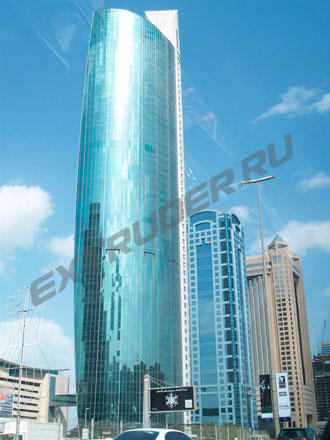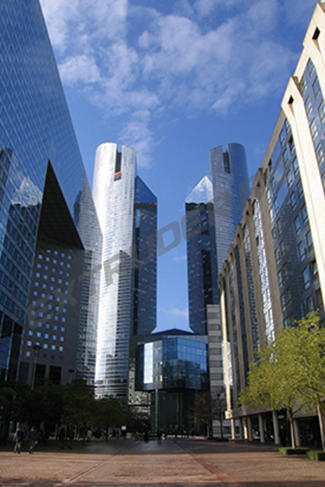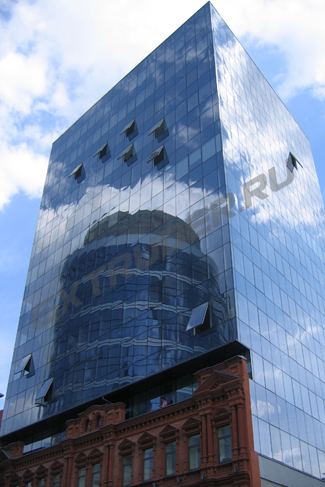Structural glazing
Structural glazing is one specific type of glazing in which all or just some parts of the mechanical load are transferred from the glazing to the building elements and are held by a secondary sealant - structural silicone sealant (silicone). By mechanical loads one can understand all types of loads,including: weight, wind, shock loads, temperature differences, etc.
Structural glazing is a very demanding area of application of architectural glazing, where the quality of the project is put in the first place, for which not all silicone building sealants are suitable. Therefore also employees of a company with a high culture of production must undergo appropriate training and a qualified interaction between the manufacturer / supplier of structural sealant - the manufacturer / equipment supplier - production – and finally the end customer plays a particularly important role.
Some of the difficulties with structural glazing are the lack of experience of our customers, the complexity of calculations and the underdevelopment of the regulatory framework. The aim of extruder.ru is to provide, based on the personal experience of our clients, business recommendations in realizing your project from A to Z and to provide you with full technical and consulting support concerning the use of silicone sealants in structural glazing. We cooperate with all leading players in this market and have a great deal of experience in this field. Therefore our position is based on knowledge about this vtopic, objectivity and professionalism. Our employees have been trained in structural glazing from a manufacturer of structural sealants and have received the appropriate and required certificate.
The following structural silicone sealants are most widely used in the worldwide market: American Company Dow Corning (Dow Corning® 3362, Dow Corning® 3363, Dow Corning® 993), Swiss Company Sika (Sikasil® IG-25, Sikasil® IG- 25 HM Plus, Sikasil® SG-500, German manufacturer Kömmerling (Ködiglaze S, GD 920), GE Silicones (IGS3723, IGS3763, SSG4400 UltraGlaze, SSG4600 UltraGlaze) of the American Cornern General Electric Company and last time Chinese suppliers Junbom Group (JB-8800) and SILANDE (MF881-25).
The most common types of structural glazing:
- 4-sided structural glazing: the most common, simple and inexpensive structural glazing; glass on all four sides is supported by structural silicone.
- 2-sided structural glazing: here structural silicone accepts loads from 2 sides; 2 other sides are supported by the frame or by other non-structural ways.
- Double-glazed windows “stepped glazing“: the outer glass from 1, 2, 3 or 4 sides is larger than the inner glass. It is used for joining joints of structural glazing on the inner surface of the outer panel or for rotary elements.
- Inclined glazing: glazing of non-vertical facades (anti-aircraft lights, roofs and other elements of modern buildings). Triplex/laminated glass is commonly used according to European standards.
- With panoramic view: 2-sided support with glass ribs for structural support of panoramic glass.
- Frameless systems ("spiders" ): such systems look like structural glazing, although structural sealant is not always used (e.g. for fixing only the inner windows of double-glazed windows). In all frameless glazing systems, silicone sealants play an important role in protecting joints from moisture penetration and in maintaining their proper insulating function.
- Impact-resistant glazing: due to the unique physical and chemical properties of silicones (viscoelastic properties, long-term adhesion, wear resistance, resistance to UV radiation, fire resistance) that organic sealants do not possess, structural silicone sealants with high performance characteristics are a very good choice for impact-resistant glazing (withstands explosions and storms) and fireproof glazing.
In addition to important operational properties (durability, water tightness, heat conductivity, sound insulation, etc.), structural glazing gives the facade a sleek modern appearance, airiness and transparency. Moreover the premises acquire natural light and visually become larger. From an aesthetic point of view, structural glazing is clearly more profitable, creating a feeling of lightness and at the same time providing a monolithic appearance of the building and totality.
Buildings are good witnesses of history in the sense that, looking at the building and the ratio of the use of glazing to the area of the facade as a whole, you can accurately determine when it was built. For example, buildings of the last century of the 50s are very different from the 80s and 90s. Modern buildings with the active use of facade and structural glazing have already entered our everyday life and their share in the 21st century will grow steadily.
There is no extruder that can work for example on polysulphide in the morning and silicone after lunch. A separate dedicated machine is required. The choice of an extruder for structural glazing ("silicone extruder", an extruder for structural silicone) should be taken with special care, as there are nuances that should receive attention. No savings or ignorance will cover the costs if the structural packages are of poor quality and – God forbid- begin to fall out from high floors of the buildings. Our employees have experience in implementing structural projects and hold all required certificates especially the European Certificate of training in Europe. Rely on our professionalism and practice.




